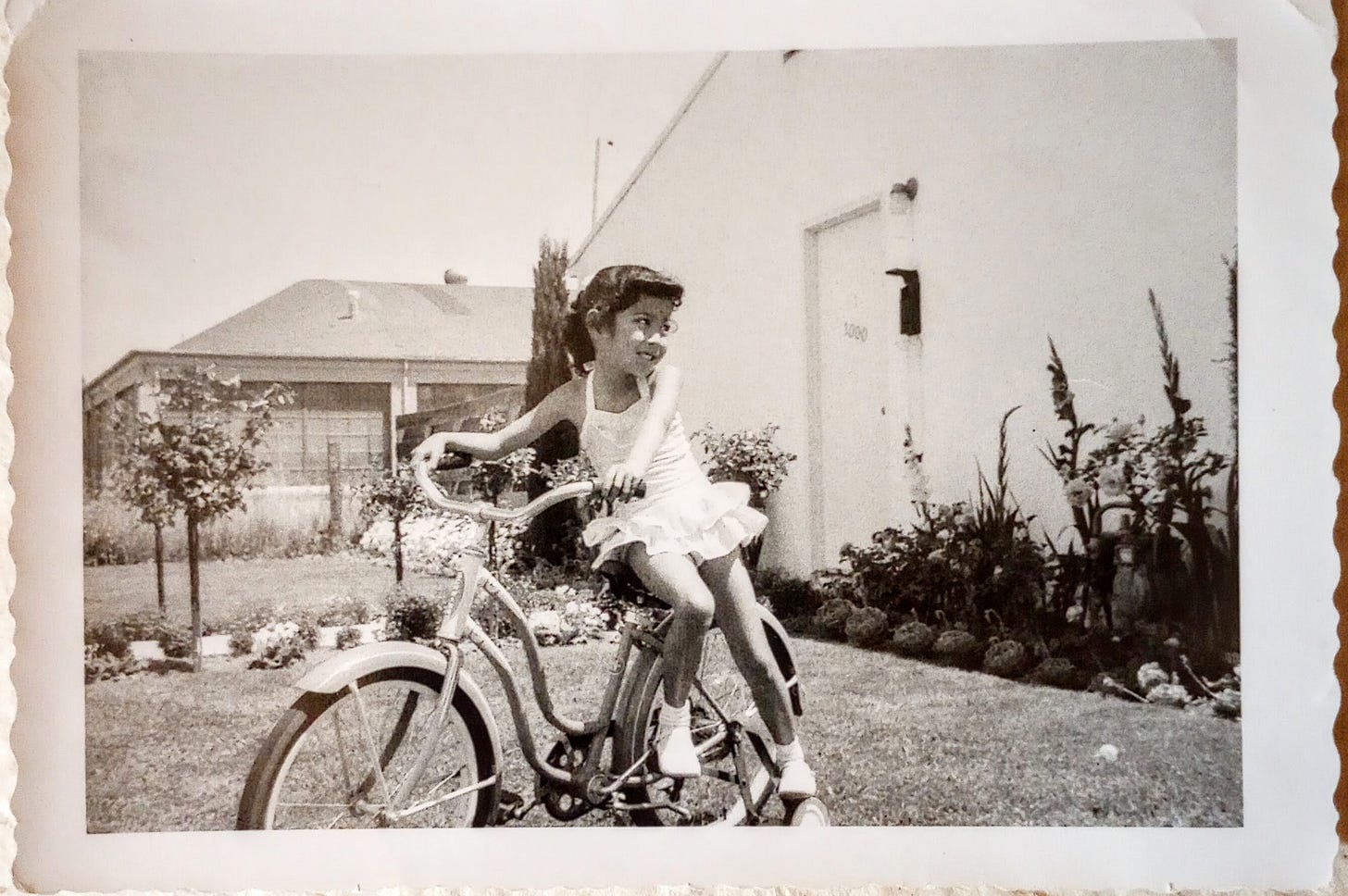The Other Side of the Tracks
#182: Then & Now, Lillian Pitt, Karen Margolis, Six Artists on Substack, Tim Bernardes, Julien Cohen, Natalia Lafourcade
THEN
We had secured our dream house in the new “suburbia.” Santa Cruz was already a resort town, thanks to its location on Monterey Bay. But as it turned out, our side of town was on the “other side of the tracks.” I’ve seen many industrial neighborhoods, and the one bordering our street1 was small and far from the worst. After the dust cleared from construction and the asphalt had been laid, I remember it as a clean neighborhood, occupied mostly by working-class veterans and their families, people who were ready to bootstrap their way to the American Dream.
God knows what kind of post-war PTSD2 dramas took place in those houses, but everyone seemed to be producing babies, and everyone worked hard. That working class mindset was the air we breathed. All the lawns were fastidiously mowed by neighborhood boys saving up coins for a new bike. Babysitters were everywhere, because they were needed. Dads drove milk or ice trucks and worked in gas stations3; moms worked in locals factories or became “housewives”—a challenging job in itself.
If the neighborhood that we called “the west side” became too confining, we could at least walk, bike, or drive the ten blocks to the ocean, with its fresh breezes and sandy beaches.
Still, we couldn’t escape the smells and noise of industry. Our backyards bordered a warehouse where metal items were fabricated, the Santa Cruz Shirt factory,4 and further down the street a factory that I couldn’t quite identify. It distinguished itself from the other factories by the pools of steaming red liquid pooled in the yard behind the building. The pools were surrounded by piles of what looked like salt crystals—visible only from the railroad tracks I traversed on my way to school. Diagonally across the street from our house was the Birds Eye Cannery, conveniently located alongside the railroad. The cannery sorted and canned produce from the “vegetable basket of America”—the Pajaro and Salinas Valleys.

The rotting Brussels sprouts stink from Birds Eye was famous on the west side. It seemed to emanate from a single conveyor belt leading out of the cannery and up to a tall metal structure right next to the street. Discarded sprouts traveled up the conveyor belt and into the structure, then dropped down into a large watery cistern. Sometimes, on my way to school, I would stop and stare at the sprouts plopping into the water. I could smell the vegetable rot at my elementary school, nearly a mile away from the cannery. Even worse, I could smell the sprouts on my mother’s apron when she arrived home from work.
Mom must’ve taken my father’s budgetary worries to heart. His merchant marine or military transport paychecks covered the mortgage and kept us fed, but that was about it. Our plain, white stucco house looked bare, and Mom desperately wanted to buy furniture, plants, and appliances. She decided she had to get a job. I hadn’t started school, yet, and this was my introduction to babysitters. Fortunately, they were plentiful.
Although Mom had worked in a Manila bank, and later attended secretarial school in San Francisco, the only job she could find near our neighborhood—we didn’t have a car in those days—was in the factories. Because she had an associate degree in home economics, and loved designing dresses, she applied to the Santa Cruz Shirt Factory next door, and got the job.
That didn’t last long, though, and I don’t recall Mom ever explaining why. Her next job was more challenging; she took a job at the Birds Eye Cannery. Thus began my career as a latchkey kid.
Old 1950s Birds Eye Orange Juice Commercial, from Vintage Fanatic:
NOW
I realize that I don’t have much to say about the “Now” in my “Then & Now” report, mostly because so much has been happening in the US during the last few weeks that is unusual and disturbing that I feel I’m still getting my bearings. However, I met up with a few artists today, and that helped. Sometimes the art you make is the best expression of that which you don’t yet have words for.
RABBIT HOLE
Warm Springs (Oregon) Native American artist Lillian Pitt had a vision
A conversation with installation artist Karen Margolis:
I assemble sculptural installations from the dismembered remains of older artworks. My process is both destructive and rehabilitative, involving deforming, unraveling and burning maps and wires into damaged parts that I repair with thread and regenerate with vibrant colors. Teetering between growth and disintegration, the constructions are like life, messy and chaotic in a constant state of transition.—-Karen Margolis
A few thought-provoking and inspiring artist’s newsletters found on Substack:
Nico Sakaki’s Art Haven
Francis Choquet’s Typochondriac Weekly
Rachielle Sheffler’s Baguio Girl
Nishant Jain’s The Sneaky Art Post
Jacqueline C’s Private View
SOUNDINGS
Checking out music sites and videos is dangerous for me, because if I’m not careful I can be there for hours. Last night I fell into a Latin vortex, and came up with:
“Vapor Barato” performed by Brazilian singer/songwriter and producer Tim Bernardes with full orchestra, from a Tribute to Gal Costa (Sala São Paulo, with Orquestra Sinfônica do Estado de São Paul ) - November 2022:
In Havana, Cuba, Julien Lopez and friends make music with the bare essentials, singing Buena Vista Social Club’s “Chan Chan.” Lopez also does a lovely cover of Natalia Lafourcade’s “Tu si Sabes Quererme.”
Natalia Lafourcade sings “María la Curandera” (En Vivo):
“Put love instead of sugar in your tea, drink it, and look at the stars. . .”
—Natalia Lafourcade
My gratitude goes to everyone who reads Eulipion Outpost regularly, and especially to those who have subscribed or donated on my Ko-fi page to support my efforts.
My ongoing appreciation goes to the Mysterious M. for his excellent editing skills.
Website and blog: Jeanvengua1.wordpress.com
A Crooked Mile (a blog)
CommonwealthCafe (Filipino American & AAPI history and print culture)
Eulipion Outpost is a reader-supported publication. To receive new posts and support my work, consider becoming a free or paid subscriber.
Our back yards faced the industrial zone, which was bisected by Fair Avenue. I had mentioned previously that the street was the site of the old Fair View racetrack. But after snooping around on history sites, I learned that the track was developed by one James G. Fair, and that he was more than a racetrack entrepreneur. He also owned a silver mining company called “The Bonanza Firm” (no kidding), and established the South Pacific Coast Railroad that ran from Pajaro Valley past our house in Santa Cruz, and north along the coast to the Davenport Cement Plant. He was also the first U.S. Senator from Nevada to have a street in California named after him.
Back then it was called “combat fatigue” or “battle fatigue.”
Except, of course, for my dad—who was always away at sea.
Owned by Carl Boppell.





It's very nice to see another Filipino writer!
Thanks for sharing your childhood neighborhood with us.